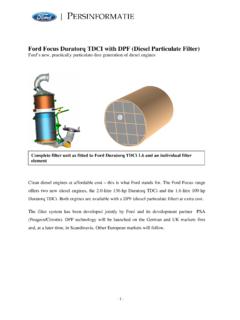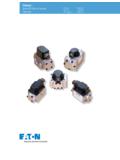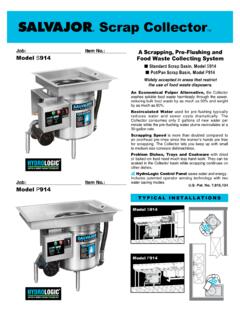Transcription of Ford Duratec 1.6 Ti-VCT Four cylinders, 16 valves, …
1 - 1 - Ford Duratec Ti-VCT four cylinders, 16 valves , two fully variable camshafts In their pursuit of improving the automobile, developers have traditionally had their eye on ever stronger engines. Ever since internal combustion engines began powering vehicles nearly 120 years ago, generations of engineers have considered larger valves with longer opening durations as the "yellow brick road" towards their dreams of greater engine performance. The internal combustion engine's 120 year development has been marked by this quest for additional power. Engineers mostly focused their attention on longer valve duration and increased overlap to achieve this. Racing engines were often the prototypes for later production engines.
2 The traditional dominance of pure power increases has only taken a back seat to other developments in recent decades as exhaust technology and its numerous implications began to drive engine development. Racing technology has also by and large ceased to provide the model for production series development. Only now is the focus of vehicle engineers shifting back to power train technology emphasising driving dynamics and hence driving pleasure. Greater flexibility in valve timing promises to deliver a higher quality engine that is more fun to drive, without compromising on low exhaust emissions and good fuel economy. At Ford, the road towards this type of progress is being paved by a new technology: fully variable valve timing, or Ti-VCT which is the engineers' abbreviation for "Twin independent variable Cam Timing.
3 " Ti-VCT uses two camshafts controlled by continuously variable actuators. This is a second-generation system with hydraulic variation of the camshafts in the direction of rotation, helping change the duration of the valves ' opening relative to the piston position. A number of similar variable valve timing mechanisms have been used in past engine systems. These systems typically only offered a choice between two timing options: "early" or "late" that is a choice between two positions of the camshafts . Unlike previous systems, the hydraulically actuated positions of the camshafts are not limited to just "early" or "late". The Ford Duratec Ti-VCT system is map-controlled according to the required engine load; in other words according to the relationship between the position of accelerator pedal and engine speed.
4 The system's ability to respond to a wide range of situations is a supported by measurement of 2000 parameters in various program maps, all of which have been carefully and continuously refined by Ford engineers during the course of the development project. The Ford Duratec Ti-VCT engine uses a double-flow catalytic converter. All of the mechanical components of this modern variable cam timing system are located inside the wheels driving the double overhead camshaft. - 2 - The novelty of Ford s approach is the application of this complex independent twin cam technology to a fuel-efficient petrol engine. This engine had already undergone optimisation to achieve excellent fuel economy and low emissions of untreated exhaust gas.
5 Fitting this unit with a map-controlled variable camshaft timing system significantly expands the engine s potential. The power delivered by Ford Duratec L Ti-VCT has been increased by a respectable 15 hp over the original from 100 to 115 hp. Remarkable, as well, is the engine s peak torque development of 155 Nm. Impressive as these figures are, these power improvements were not the primary motivation for the new developments. Exhaust Intake Valve Overlap Variation controlled by programme map Ignition Valve lift Engine Conttrol Unit OCV Crank Position Sensor Cam Position Sensor VCT Unit Inlet Cam Oil Pressure Control Valve The characteristic trait of the Ford Duratec Ti-VCT system is its fully variable control of both camshafts , driven by the parameters variable control of both camshafts is performed by two vane-type rotors inside the wheels driving the camshafts .
6 This control is based on a precisely defined programme map and powered exclusively by the engine s operating oil pressure VCT Unit Exhaust Cam - 3 - The fact that the Duratec DOHC engine develops its high torque levels across an unusually wide range of engine speeds is a true breakthrough. This can be seen in the fact that while the engine develops its peak torque of 155 Nm already at 4000 rpm, it already comes very close to doing so at 2000 rpm. For a naturally aspirated engine, the torque curve shows exceptional, plateau-like characteristics, rising quickly and then levelling out across a wide range of engine speeds in a way normally found only in more complex, turbo-charged engines. Ford Duratec Ti-VCT shows an impressive torque curve over a wide range of engine speeds.
7 Engine Performance Indicator: Specific Mean Pressure Specific mean pressure, pme, is a particularly good factor for describing the performance of modern engines. It is determined by dividing maximum torque (expressed in Newton metres) by engine size (expressed in litres) and multiplying the quotient by the non- variable factor of (pme = Mdmax /Vh x ). The result of this calculation represents the mean combustion pressure inside the cylinder in bar. Regardless of the size of the engine, this value provides a measure for the quality of the engine s torque. The Ford Duratec Ti-VCT 's pme of bar is exceptionally high for a naturally aspirated engine. Moreover, the fact that this value shows only minor variations across wide ranges of the engine speed band is further proof of the unit s high quality.
8 This factor, in and of itself, marks Duratec Ti-VCT as an effective and efficient engine, offering high levels of agility across a wide range of engine speeds. - 4 - Technological Basis In essence, the fully variable valve timing system used by Ford Duratec Ti-VCT only requires three different elements. Two hydraulic control elements, so-called phase actuators, are located inside the wheels driving the camshafts . The effects of oil pressure and spring action enable these elements to vary the camshafts , according to engine speed and load range. Two hydraulic, four -to-three-way-type valves serve as control elements. These assist in either retarding or advancing the valve timing.
9 The hydraulic connection between the oil circuit and the variable camshaft control system is provided by a newly designed bearing support for the camshafts . This construction contains the ducts for the hydraulic control elements in addition to the usual oil ducts supplying the camshaft bearings. In the Ford Duratec system, these are "driven" exclusively by the respective operating oil pressure of the engine. D ENSO C orporation , All r ights res tem C ontrol C o mponents Prod uc t D ivis ionActuation Components of Ford Duratec Ti -VCT Vane rotor(F ixed to cam shaft)Vane housing(F ixed to sprocket)Stopper pinCam shaftAdvanc eC hamberR etardC ham berOCV(Oil Flow Control Valve)PP Basic Characteristics of Engineering Design To understand better the way in which Ford s variable valve timing system works, it may be helpful to briefly review the conventionally known extremes of engine characteristics.
10 Back in the nineteen-fifties and sixties, standard production engines typically used somewhat "restrained" valve timing, characterised by short duration and overlap. While this resulted in low engine output, it gave very stable idle speeds. This gives these old engines their characteristic feel of a lot of "muscle," always a surprise to someone driving one of these "oldies" for the first time today. A litre engine of that time delivered 55 to 60 hp, then, was roughly half of that produced by a modern engine. Engines dating back even further to the fifties even top this. They practically "pull the torque-rabbit out of their hat" at such low engine speeds that, by today s standards, comparing them with a locomotive may seem more appropriate than with an automobile.








